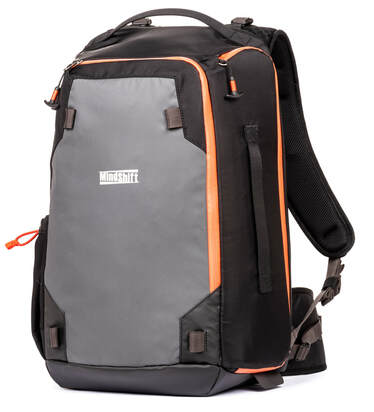 MindShift Gear's PhotoCross 15 Backpack. Courtesy Think Tank Photo.
MindShift Gear's PhotoCross 15 Backpack. Courtesy Think Tank Photo.
 MindShift Gear's PhotoCross 15 Backpack. Courtesy Think Tank Photo. MindShift Gear's PhotoCross 15 Backpack. Courtesy Think Tank Photo. There’s no question that, when it comes to outdoor photography, whether close to home or far away, my go-to camera bag is a backpack. Which is why I welcomed the opportunity to field-test MindShift’s new entry in their PhotoCross lineup, the PhotoCross 15. So, did the PhotoCross 15 meet all my expectations? Will it become my go-to camera bag on outdoor adventures? And what features set it apart from the traditional sling or backpack? Let’s see…
A Quick Look at the New MindShift BackLight 18L I’ve previously written extensively about the BackLight series, which, until now, consisted of two larger bags, first the 26L, followed by the 36L – the model number reflecting capacity, in liters. That makes this bag half the size of the largest version, at least in carrying capacity. I still use the 26L, having gifted the 36L to a friend who routinely carries a load of gear, and when the 18L arrived, I thought it would be too small for my Tamron 150-600mm G2. I first tried the 18L out with my Nikon D500 attached to the new Tamron 100-400 (look for a review of this lens shortly). It was a perfect fit. Next came what I thought would be the impossible task. On its own, the 150-600 settled in comfortably. But could I say the same when attached to the camera? Well, I did have to move a couple of the padded divers out of the way, but I managed a good fit. Of course, that shift in the partitions negated the use of the other half of the bag for a second camera with attached lens. Well, I could always carry a second body and lens separately – plenty of room for that. In the backpack's factory configuration, when situating the camera with 100-400 attached (at the top of the bag, lens downward), there was plenty of room for that second body with attached lens (cradled from the bottom of the bag, lens upward). Long and short, I’ll still use my 26L for that monster glass and relegate the 18L for the D500/100-400 combo riding side-saddle with, say, a D610/90mm macro attached – and still have room for a Nissin flash. You can read my earlier reviews by clicking these links: BackLight 26L review BackLight 36L review I should point out that I was so happy with the BackLight 18L that I gave my trusty TrailScape 18L to a friend in favor of the new bag. I prefer the interior layout of the BackLight 18L, considering it will hold two cameras with attached lenses right from the get-go. MindShift’s Exposure 15 Shoulder Bag When it comes to shoulder bags, my preference runs to smaller bags. I find it more fatiguing when wearing even a small shoulder bag or sling bag than when carrying a fully loaded backpack. Still, a shoulder bag does come in handy on occasion. You won't carry a backpack to a formal occasion, or even when visiting friends. Not to mention, it's so much easier to stow a shoulder bag on the floor underneath or alongside your seat when dining. I already own and use the perfect shoulder bag, Think Tank’s Signature 13 – elegant styling, functional, and small enough to carry just what I need for streetshooting. So I wasn’t about to make that bag redundant with the Exposure 13. Besides, the larger Exposure bag sported more spacious pockets – and I love pockets. Still, the Signature bag lacks one thing that, to my mind, would have made it perfect: a waist belt to take the weight off my shoulder. It would have been very easy for Think Tank to have fitted the bag with a removable waist belt, but that probably would have run counter to the fashion statement that bag makes. Fast forward to the Exposure series. These bags don’t feature a waist belt, but they come with the next best thing: a security tether, or what MindShift calls a "cross-body stabilizer strap." This keeps the bag from slipping off your shoulder – or swinging around and in your way when you bend down to shoot something low to the ground. It also prevents someone from pulling the bag off your shoulder. You can also wear the bag sling-style, which is how I’d been using it, and how it was primarily designed to be worn. The neoprene shoulder pad is sewn in and runs much of the length of the strap, rendering the strap well suited to either mode of portage. This bag also features new materials that make it practically impervious to the elements, and the lid has flaps at either end to keep out dust, flying debris, and rain/snow. It does not have a zipped inner lid, a trademark of the Signature bags. However, the Exposure uses only a single plastic buckle for fast access. Some Velcro-type closure system wouldn’t have hurt, so you wouldn’t have needed to constantly snap the buckle shut. It’s a noisy prospect when you’re trying to remain quiet while focusing on birds or other wildlife. As for the interior of the bag, it too lacks the finesse of the Signature bag, but, having said that, it does provide the needed protection. I was able to fit my D500 with attached 100-400, standing the rig lens downward inside the bag. With a shorter lens, the camera could have been supported by the dividers along both sides. Still, even with this long lens, the flap closed without any unruly bulge. BTW – carrying this combo was another reason, perhaps the main one, I’d opted for the larger Exposure 15. The Exposure 13 would have been too small. I should also note that the Exposure 15 will carry a 15” laptop, along with a tablet. There are numerous other pockets, along with a luggage-handle pass-through so you can piggyback the bag on your roller luggage. A tripod is carried at the bottom – straps included. Also included is a rain cover, not that you’ll need it in a light rain, since the bag is sufficiently weatherproofed on its own. Oh, and if that’s not enough, there’s also a water-bottle pocket that will comfortably hold your average-size water bottle.
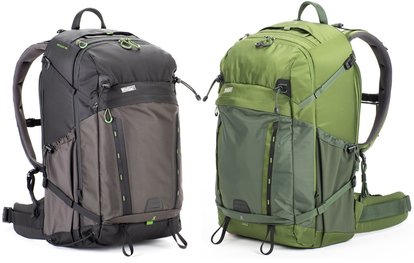 It was nearly a year ago that I tested the progenitor to the BackLight series, the BackLight 26L, from MindShift Gear. That pack has become a staple in my stable of carrying gear, which includes a variety of MindShift and Think Tank Photo products. I’ve grown to rely on them for their utility and durability. And these days, I’ve been leaning toward smaller bags that limit what I carry. I prefer to arrive home after spending hours on my feet little worse for wear, and lighter loads allow me to do that. I also find I work faster and more efficiently if I can work economically. Anyway, so this BackLight 36L arrives on my doorstep. It’s a full 10 liters bigger than the previous model, which I use mainly when shooting with my Tamron 150-600mm G2. In fact, what that translates to is, the 36L is taller, wider, and deeper. So the question you have to ask yourself when choosing between the two versions is, how much backpack do you really need? But even before you go there, take a closer look at the pack and you’ll notice something different – something that sets it apart from other MindShift (and competitor’s) backpacks. Hint: it has to do with camera access. The name should give you a hint. The Design - The Good and the Bad In contrast to typical backpack designs, the BackLight employs a rear-access panel, rather than a front panel. (Front outer pockets hold a variety of other stuff, as we’ll see.). It’s a zipped, drop-down panel, but by giving you access to your gear from the rear, you keep prying hands away from your precious cameras and lenses. It may take a little getting used to at first if you’ve been using a more traditional pack, but, provided you’re not switching back and forth, as I am wont to do, you should have a firm handle on it after one or two outings. MindShift will try to tell you that you can change lenses on the fly, without removing the bag from your body, thanks to this rear panel and a short neck cord found inside the bag. I tried it with the 26L. It didn’t fly. And with an even bigger and heavier bag, I’m not even going to attempt it. Frankly, I wish they would have removed that cord, since it always came undone on the smaller bag. And it was not very comfortable.
Room for a Laptop, a Tablet – and a Tripod Rear access means you can carry a tripod centered over the front of the bag for better balance on uneven terrain. All the accoutrements are in place, but neatly tucked away top and bottom. Or you can carry the tripod on either side, with a water bottle on the opposite side. If you’re mostly traveling over flat terrain, side-carry is not a problem. Keeping the tripod over the center makes more sense for the long haul, but it does get in the way when laying the bag down to get at gear. And if you carry a tripod, you definitely do not want to use that neck cord to change lenses while still wearing the bag. I don’t know about you, but I never take my laptop into the field. Still, if that’s your preference, this bag lets you do that – inside a padded sleeve. Not only that, but you can also carry a tablet. The tablet sleeve isn’t padded, but the surrounding pocket is so voluminous that you’ll likely keep a jacket and other stuff in there to cushion against bumps.
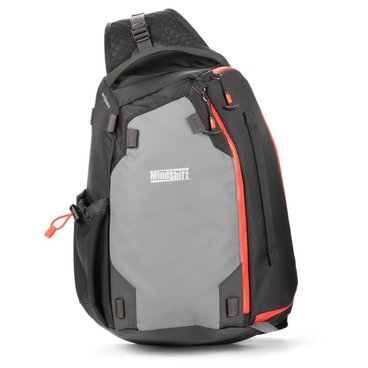 PhotoCross 13 sling pack (orange ember). Courtesy MindShift Gear. PhotoCross 13 sling pack (orange ember). Courtesy MindShift Gear. If the PhotoCross 13, from MindShift Gear, can hold my Nikon D500 with Tamron 150-600mm G2 attached, imagine what other combinations of gear it can carry! That’s the surprising discovery I made on the third day working with this bag. But first allow me to detour for a moment with some thoughts on choosing between a sling and backpack for your photo gear. Sling vs. Backpack I routinely prefer a backpack for my photo adventures into the wilderness, and even on the streets of Chicago. More to the point, I’ve never been one to wear or even favor a sling bag when carrying camera gear, except when testing these bags. They are favored by the younger generation, I’ll give you that. Granted, when I wear a shoulder bag, namely the Signature 13, I do so largely sling-fashion, but that’s only because the strap on that bag lends itself to easy portage in this manner. And I carry a light load (read more on the Think Tank Photo Signature 13 here.) The problem with bags that carry the moniker “sling” is, in my experience, that the strap always cuts into my neck, largely due to a shoulder pad that is too stiff and inflexible. And many of these bags try to be a photo pack minus the backpack harness, meaning they strive to fit as much gear as possible, to the point where your neck and shoulder will hate you 15 minutes into your trek. So when MindShift announced the PhotoCross, I approached it with some trepidation. Little by little, the bag started to grow on me. In the end, I may have found the one sling that fits me to a tee. 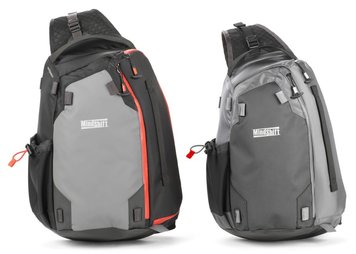 PhotoCross 13 (with orange accents) on the left; PhotoCross 10 on the right. Courtesy MindShift Gear. PhotoCross 13 (with orange accents) on the left; PhotoCross 10 on the right. Courtesy MindShift Gear. Choosing the Right Size I immediately opted for the larger of the two new PhotoCross sling bags. In determining what would be a good fit, I began with the product photographs on MindShift’s website – the pictures showing the bags decked out with a complete array of gear. The second thing I did (and do routinely) before requesting a sample bag for testing and evaluation is to watch the product video. MindShift (as well as Think Tank) keeps the introductory video short and sweet. I try very hard to read between the lines, but, I have to admit, they keep the dialog tight and to the point. So the only thing left for me to do was to order the bag I felt would be the right fit. And that was the PhotoCross 13. It proved to be the right choice. PhotoCross on the Surface Aside from a choice in size, you have a choice in color schemes. More realistically, it comes down to a choice in color accents. I chose Orange Ember, the other choice being Carbon Grey (hey, MindShift – this is the USA; we spell it “gray”! No need to get hoity-toity on us.). I would have been happier still with a bag that was predominantly orange, with gray (not “grey”) accents. The color accents around the front of the bag key us into the zipper locations. There is an outside pocket, which I wish would have been pleated to accommodate a light jacket. But, as is, it’s still functional enough to hold any non-bulky extras you may need. There’s also a pair of smaller pockets inside this outer pocket. The other zipper leads to the main camera section, with additional pockets. There’s also some accent stitching on the back – not that anyone will notice while you’re wearing the bag. Still, a nice touch. And there are other subtle color accents besides. Okay, color schemes aside, let’s get down to the nitty-gritty. The body of the bag maintains a fairly svelte appearance. That’s not a fashion statement. That’s a practical feature. In the woods there’s less likelihood that the bag will hinder your progress in tight spaces and it won’t bump into people on buses and trains. Well, the tripod hanging off the back might, but you can always hand-carry it till you reach a clear path. The PhotoCross Harness System This sling pack features a one-piece, adjustable shoulder strap, with thin, air-circulating, mesh-covered padding lining much of the strap. There’s a stretch of similar padding extending out from the base of the bag, which falls against your lower back. I wish this padding ran the entire length of the strap for added comfort. That same mesh lines the back of the bag. However, lacking the raised shoulder and lumbar pads usually found on a backpack, this really didn’t provide much cooling. But there’s a way around that (read on). The shoulder strap has no buckles to fasten and unfasten. While fasteners do make it easy to remove the bag when you’re seated, in every other conceivable situation, they’re a nuisance – and a potential hazard. With gravity and inertia taking over, you may lose your grip on one or both straps when trying to snap the ends together, or when unsnapping them, with the potential for the bag to come crashing to the ground. And to sweeten the deal, there is even a set of compression straps – one at the top, another at the bottom – so you can better tailor the shoulder strap and ultimate fit to your comfort level. By this means you can separate the bag from your back a bit more for improved air circulation. What’s more, there’s no sliding shoulder pad that you constantly have to readjust. The padding is part and parcel of the strap, so it moves with the strap. And, again, the soft padding on this bag ensures your neck won’t chafe from a stiff shoulder pad. You may still find yourself adjusting the strap to optimize your comfort level, but that’s something one does normally when wearing any bag. There’s also a tuck-away waist belt. It’s largely there in case you’re negotiating treacherous terrain and want to prevent the bag from shifting and throwing you off-balance. Couple that with a pair of hand straps to help you get a better grip on the bag. Add to that, the bag employs reinforced box-X stitching at stress points on the main handle. And the stitching on the bag overall is immaculate, with nary a loose thread that I could find. 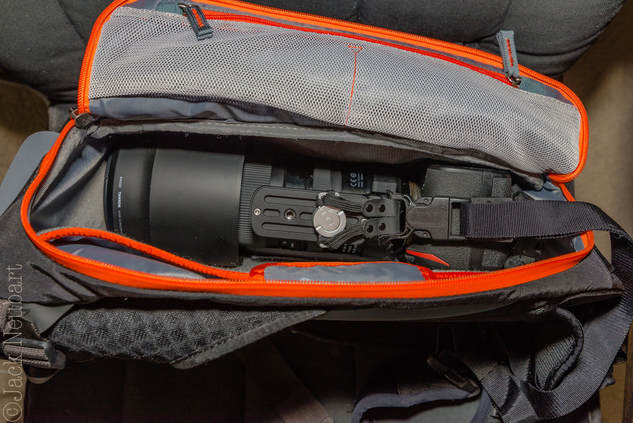 PhotoCross 13. I pulled out the dividers, positioning one as a "floating cushion" beneath the lens, then parked the D500 with attached Tamron 150-600mm G2 cozily in the bag. PhotoCross 13. I pulled out the dividers, positioning one as a "floating cushion" beneath the lens, then parked the D500 with attached Tamron 150-600mm G2 cozily in the bag. The PhotoCross 13 in Use The bag is meant for a casual walk in the woods or on city streets, with a modicum of gear. You’re not going to get a gripped DSLR and long, fast lenses in here. The main camera section has three, fully adjustable modules, with movable padded dividers (via Velcro-type hook-and-loop fasteners). What will that fit? I’ve carried a 70-300mm attached to the camera, a flash in the second module, and various accessories including sling strap in the third. Actually, you’ll be surprised at how much you can squeeze into this bag. What’s more, I was pleasantly surprised when I was able to load my D500 and 150-600 zoom into this bag. It was a tight fit and getting this combo back in the bag while I was wearing it required a bit more of an effort than when removing the gear. It was also fairly easy to load this combo into the bag before donning it. I also managed to fit the Nissin i60 in a soft pouch on top when I'd started out. If you’re wondering, if I had to remove the tripod mount on the 150-600, the answer is no. I inserted the camera into the bag lens first, camera grip upwards (portrait mode). And I rotated the tripod mount so it rested facing upwards, making it easy to grab the mount as a handle and pull up. Once out of the bag, the tripod mount was returned to its original position. There’s also a tablet sleeve inside the camera section, lying against your back. I say “tablet,” not “laptop,” because I can’t see anyone schlepping a laptop of any size, unless it weighs no more and is no bigger than a tablet (contrary to specifications). I’m not even sure I’d carry a tablet, certainly not with the long-lens rig just described. Perhaps I would with a smaller, lighter load. Because I wear hats, the hat does get in the way, requiring its removal when donning the pack, or removing it. A sling camera strap proved equally annoying when wearing this sling pack. I may try to sling the bag to the left and carry the camera at my right (for a fast grab – really, the only way to use a sling strap) and see how that works. Although I’ll probably just keep things as they are, being right-handed. Given that the bag’s hand strap on top falls naturally in position for an easy grab with your right hand when the bag is carried to the left, I’m beginning to wonder if that wasn’t the intended carrying method. I gave it a quick try, but it didn’t feel natural, so back to the tried and true (subject to change without prior notice). A third strap on the bottom would equal the score in terms of making it easy to grab and swing the bag around, but that may interfere with the integrity of the bottom panel, which is designed to be better resistant against wear to vertical placement and scraping of the bag on rocks and dirt. All that aside, what’s important is that the entire time I wore the PhotoCross, I never felt as if it were choking me or cutting into my neck. One thing I should point out. It may take a bit of trial and error to get the shoulder strap just the right length, while adjusting the compression straps for maximum comfort. For now I have the bag flush against my back at the top, but looser at the bottom, which seems to work for me. Look for a review of the Nikon D500 and Tamron 150-600mm G2 soon.
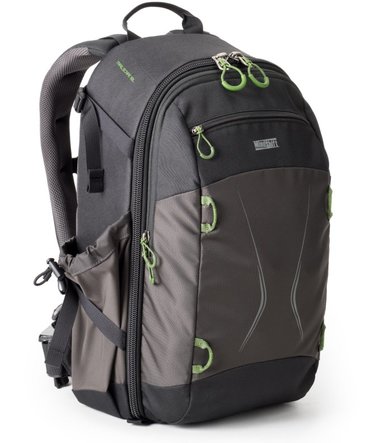 Courtesy MindShift Gear. Courtesy MindShift Gear. The moment I unpacked this photo backpack and unzipped the main flap, I had a sense of déjà vu. I’d seen this bag before. Then I took a look at my Think Tank Photo StreetWalker and realized where I’d seen this design. The new TrailScape largely mimics the interior of the StreetWalker, or perhaps more correctly the StreetWalker Pro, since the dimensions more closely match that pack. But there are substantive differences. What are they? Read on. The TrailScape – On the Outside Gone are the two zippered side pockets found on the StreetWalker. They are wisely replaced by two roomier stretch pockets. Granted, some may lament the loss of these zip pockets, but I always found them a bit too cramped for my taste. Instead, you now have room for a 32-oz. Nalgene water bottle on one side, counterbalanced by your tripod snugly secured by compression straps, with two feet (spikes retracted) resting inside the opposite stretch pocket. On the front, there is a very spacious pocket that will hold a 13” laptop and a 10” tablet, not that I ever carry either into the field. But I do make use of these sleeves for maps, pads, and various accessories. There are also organizer pockets in this section. In front of this large pocket sits another pocket, diminutive by comparison, designed to carry your sunglasses, with a very softly textured fabric lining that shouldn’t scratch. I’ve got a pair of those sunglasses that are so bulbous when closed that they require a custom case. They fit here. But I was so afraid they’d get crushed at some point, that I removed them and put them back in their hard case. In their place went my Giotto’s rocket blower. The zippers run very smoothly. However, I would have preferred contrasting colors for the zipper pulls on the front pocket. Yes, the zip pulls, which are designed to be easily handled with gloves, are smaller on the pocket. But I did manage to grab them by accident. So my solution was to rest them on the side, with the main zips up top. Problem solved. Because this is a trail pack, in contrast to the zips on the StreetWalker, the zippers are not interlocking (for the purpose of inserting a TSA lock). Besides, locking a bag only makes it that much more tempting to those looking to steal it. There are four lash points on the front of the bag, but you’ll have to supply your own rope or bungee cord. If you need to carry stuff inside the front pocket to keep it safe from the elements, you can lash a jacket to the front of the bag. I keep a light jacket inside this pocket. There’s a carrying handle on top – more of a strap, really, coming to rest on the back of the pack. While not nearly as substantial as the one on the StreetWalker, such straps have been used on other packs (I believe also from MindShift or Think Tank), and I’ve never known them to fail. Besides, in contrast to that other bag, this handle doesn’t add to the height of the bag – which could make a difference when you’re trying to squeeze into a tight overhead bin or under a seat. (By the way, if you’re going to carry the pack for any distance, by any means other than fully on your back with both straps, use one of the shoulder straps, not the carrying handle.) On the Inside This pack is not nearly as deep as even the original StreetWalker. What does that mean? Forget about carrying a pro-grip camera, unless you insert it face-up sans lens. That said, my Nikon D610 rides much more secure in this bag, because it’s less of a bouncy house (although, I must admit, I always secure the camera with a Velcro band over the dividers or I’ll seat another divider over the lens for a snug fit). There are plenty of padded dividers. As is, this pack is fitted for a slew of lenses, accessories, and a flash. My dividers never sit in one place for very long, however. That’s the beauty of a customizable system. There are also two mesh pockets inside the front lid for small, chiefly flat items. In Use The first thing I have to comment on is the backpack harness system and airflow/lumbar padding. In a trail pack, this is of utmost importance for your comfort and safety during long treks, especially over arduous terrain. While this pack is not meant for such outings, by its very nature, still, it’s comforting to know it will stand the test. The harness system on the TrailScape feels better than the one found on the StreetWalker. The straps are wider at the shoulder. The straps on both packs are contoured top to bottom to fit the body nicely, but this one is decidedly a better fit. As with the StreetWalker, the unpadded waist strap is removable. (Keep it inside the bag, or you’ll lose it. Better yet, leave it attached – reattaching can be a chore if you didn’t take notes on how the straps originally attached to the bag). The sternum (chest) strap on the TrailScape is longer and a bit stretchy for larger chests or someone wearing lots of winter layers. On my initial outing, I didn’t find it necessary to use either the waist belt or chest strap. The pack rode comfortably on my back without requiring constant adjustments. By the way, when you first get the pack, it’s important to loosen all straps. Tighten them when the pack is on your back, and adjust them once on the trail. You’re probably thinking that it’s odd this pack doesn’t allow for a hydration bladder, whereas the more compact SidePath, which is essentially an enhanced daypack, will accommodate a bladder. I’m guessing, that, when you start with one basic design, namely the StreetWalker, it would be difficult to create a custom passageway for a drinking tube without destroying the solid fabric of that pack. And frankly, I’m not a fan of bladders, so this doesn’t bother me in the least. If you must use a bladder, MindShift has several alternatives available, currently the rotation 180 packs.
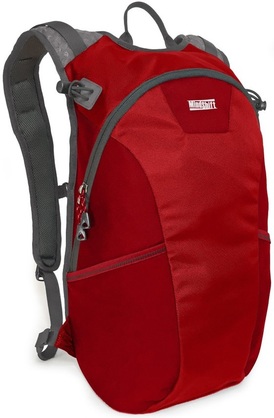 Photo courtesy MindShift Gear. Photo courtesy MindShift Gear. MindShift Gear first came on the scene with rough-and-tumble photo backpacks. If you wanted to go into the wilderness with your camera gear, this was the way to go. But with time, the company has mellowed in its direction, it seems, and has started producing photo backpacks with more mass appeal. Is this a good or bad thing? Well, it depends on which side of the fence you’re leaning. I, for one, like some of the more city-slicker-oriented designs for those of us who don’t spend days trekking into the great outdoors. But, then again, I lament that the company feels a need to trim down their packs at the expense of all-around utility. Enter the SidePath. The SidePath – On the Outside Don’t get me wrong. When it comes to materials and workmanship, MindShift doesn’t skimp. Granted, a bag such as the SidePath doesn’t share the same go-anywhere body of this company’s heftier backpacks. After all, this bag was designed to be light on your back for light hikes, walks around town, and sightseeing. Toward that end, the materials are also lighter weight. Where I feel MindShift has gone wrong with this lightweight pack is in the shoulder straps. They may be comfortable over several layers of clothing, but, as the day wears on, you may begin to feel it, especially if all you’re wearing is a t-shirt under those straps. OK, granted, I did go ga-ga over the previous lightweight pack, the UltraLight. And I had used that bag for much of the year. But over time, I did notice a difference, especially after testing Think Tank Photo’s ShapeShifter V2.0 and MindShift’s Moose Peterson V2.0, with their heftier, more substantial backpack harness systems. And that made me long for those stockier backpacks. But, then again, I’m a stocky person. Someone with a more slender frame will likely appreciate and prefer the lighter-weight of the SidePath. And, by extension, would be very happy with the existing shoulder harness. On the Inside This is a twin-tier design. That means that there’s a roomy upper compartment and a lower level. Traditionally, the lower level is where camera gear goes. Which is the case here. So you can expect the required padding and the customizable interior. The upper level is where your personal stuff goes. It has a tent-like zipper flap. The front flap has an inside mesh pocket, which is quite spacious. There’s also a thinly padded sleeve to hold a tablet. Alternately, you can fit a hydration bladder in this sleeve. I personally avoid inserting a hydration reservoir inside a pack, for fear of leakage.
Who Should Use This?
Anyone out for a light hike, a walk around town, or sightseeing, or simply enjoying a fun outing with friends and family. Capsule Comments Despite my complaints about the lack of padding in the shoulder straps, they did manage to do a nice job. I would have liked a roomier top section, so I could fit a jacket in there with my extra gear, but I’m sure I could find a way to do that when push comes to shove. The lower section was a perfect size for my D610 and attached 70-300mm zoom. Alternatively, it would also carry my D610 with Tamron 15-30mm f/2.8 attached just as snugly. If you don’t mind carrying camera body and lenses separately, you could fit more gear in here, provided none of the lenses were long or of wide girth. Conclusions I found myself liking this bag. Of course, when MindShift sends over their TrailScape, I may shift my attention to that roomier bag. Still, the SidePath does have a place among my other packs, but, more importantly, on my back. It’s compact, lightweight, and is the perfect solution for a day out with my camera. Still, MindShift, you might consider coming out with a slightly larger version, with a heftier shoulder harness. That would be my perfect bag for sauntering about town. The Moose Peterson MP-3 V2.0 photo backpack marks a departure for MindShift Gear in two respects. First, MindShift doesn’t normally take on camera bags designed and previously marketed by a third party. And, second, the interior is different from anything MindShift has offered before now. The first marks a prudent step toward expansion, which, in today’s world, makes economic and business sense for a forward-thinking company. The second signifies a long-awaited and highly significant step toward making MindShift products more user-friendly and utilitarian. As you may have figured out, this pack is the baby of wildlife photographer Moose Peterson--for wildlife photographers. It’s a vast improvement over the original Moose Peterson pack, which I’d reviewed some years back for a major photo magazine. And it stands head-and-shoulders above a similar design from another camera bag company. In fact, even hinting at any similarity is an insult to the Moose pack. 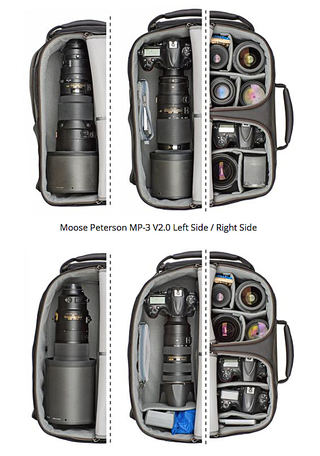 Just a few of the possible layouts for a mix of gear that's ready for any eventuality. Courtesy MindShift Gear. Just a few of the possible layouts for a mix of gear that's ready for any eventuality. Courtesy MindShift Gear. An Inside Look Professional wildlife photographers use long, fast lenses. These lenses are, by and large (no pun intended), ginormous. But many photo backpacks are not designed to easily hold them, without sacrificing much, if not all, of the available space, leaving little room for anything else. What makes this bag eminently suited to this pursuit is its tripartite design. The longest compartment is specifically designed around a long, fast lens attached to the camera or an even physically bigger lens on its own. Two smaller sections house the camera (when detached from the lens), along with a second body and even a third, several additional lenses, converters, a shoe-mount or two, and filters. When the main section is not fully occupied, there’s plenty of room for other gear. In fact, whichever size Moose pack you buy, it will comfortably hold at least one body with pro-grip, with lens attached. Each item of gear is securely nestled in place thanks to the thick but flexible Velcro-friendly dividers—a serious departure from the dividers MindShift has been using in its other packs, and a welcome change. The new dividers let you customize the interior almost infinitely, with various-sized sections. The new dividers also do a better job of hugging and grabbing your stuff so it doesn’t slide around, or out of the bag, should you open it while it’s in an upright position. All this is safely contained within a fairly rigid, padded wall that encompasses the pack. Protecting everything at the front end are three separate zipped access panels, which are padded. What’s noteworthy about these panels is that, rather than remaining open and exposing the contents to the elements, they drop back down. Just make sure to zip the panels shut before donning the pack. What would have made this even sweeter is if MindShift would have used the magnetic-locking clips, similar to the ones used on the Rotation packs, so the panels would stay closed. Then again, someone might see that as an encumbrance to quickly getting into the bag. Is It Perfect? This pack will also hold a tripod over the large front panel or on the side, using the mesh pocket. However, I’m sure you’d rather reserve this sizable pocket for a large Nalgene water bottle. Either way, it’s a workable arrangement. There’s no space for a hydration pack. In fact, as comfy as the bag is to wear, it’s best use comes from taking short hops away from your vehicle or traversing mild terrain. It’s too bulky to negotiate tight spaces. Still, I’m pretty sure you don’t plan to use this bag on long, arduous hikes over treacherous terrain or to scale steep slopes. And even if you did, feel assured that the bag will remain steadfastly on your back. There’s no room for lunch, a jacket, rain poncho, first aid kit, guide books, and other hiker essentials, unless you want to clear out a section of gear. A spacious front pocket or upper tier, where stuff like this goes, is lacking. There is a small pocket on top, where you can store filters, lens tissue, and the like, plus mesh pockets inside each flap, but none of these is well-suited to a sandwich or a change of clothes. The Moose pack is perfectly suited as a bag you’d want to work out of. The self-closing flaps help toward that end. When laid flat, the pack serves as the perfect workspace. And it’s designed to keep you well organized. To say that this pack is thoughtfully designed would be an understatement. 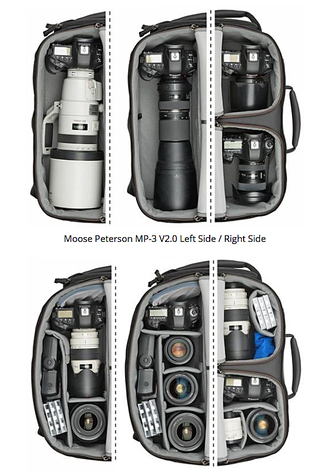 A few more possible layouts to prepare you for any situation. Courtesy MindShift Gear. A few more possible layouts to prepare you for any situation. Courtesy MindShift Gear. In Use I loaded the bag up with about 25 pounds of gear. I don’t usually carry this much gear around and dreaded the thought. Still, once I got over the shock of how heavy it felt when I first picked it up (before actually weighing the load), after donning the pack, I must say that it felt good. In fact, I’d noted that the shoulder straps didn’t slide off my shoulders. Sliding shoulder straps are a big bane on most backpacks. Still, to make carrying this load even easier, I cinched the included waist belt and sternum strap. The shoulder straps, by the way, are well padded to handle the load, as well as contoured and breathable for a comfy ride. I should point out that the waist belt, while included, does not come attached to the bag. Slide it through the lumbar pad on back of the pack. You’ll note that the strap has two hook-and-loop strips. They attach to their counterpart on the inside of the lumbar pad, so make sure to insert the strap properly (the breathable mesh goes against your waist). The tapered waist strap is thin enough to be easily stored out of the way when not in use, but ample enough to give you the needed support and comfort. You’ll note that there are no compression straps anywhere. They’re not really needed. Compression straps are required on bags designed for arduous hikes and backpacking. But to protect the zippers, at least around the circumference of the bag, there is a narrow rain flap, just wide enough to do the job, not too wide that it gets in the way. Speaking of straps, I almost forgot to mention a few things. First, there are two padded carry handles – one on top, another on the side, so you can carry the bag like a suitcase. While I haven’t had the opportunity to test it out, the bag’s squarish design makes it well-suited for overhead stowage on most airlines. And to further your efforts toward that end, the shoulder straps tuck neatly behind the airflow shoulder pads that lie against your back. (In fact, that’s how the bag is delivered to you.) Also, you can wrap the waist belt and secure it in front, to maintain the bag’s svelte lines. On the face of it, this Moose pack looks like a piece of handsomely crafted luggage. In fact, the pack appears so innocuous that there’s nothing about it that even remotely screams camera bag. Well, if you don’t count the tripod hanging in front…
MATERIALS (Mfr. specifications)
Exterior: For superior water resistance, all exterior fabric has a durable water-repellant coating, plus the underside of the fabric has a polyurethane coating. The bag also features highest-quality abrasion-resistant YKK® RC-Fuse zippers, 420D velocity nylon, 600D polyester, 1680D ballistic nylon, 320G DuraStretch mesh, nylon webbing, 350G airmesh, nylon webbing, 3-ply bonded nylon thread. Interior: High-density velex, 210D silver-toned nylon lining, hexa mesh pockets, high-density closed-cell foam, 3-ply bonded nylon thread. Field Report: MindShift Gear’s Multi-Mount Holster 50 – When a Regular Shoulder Bag Just Won’t Do7/14/2016
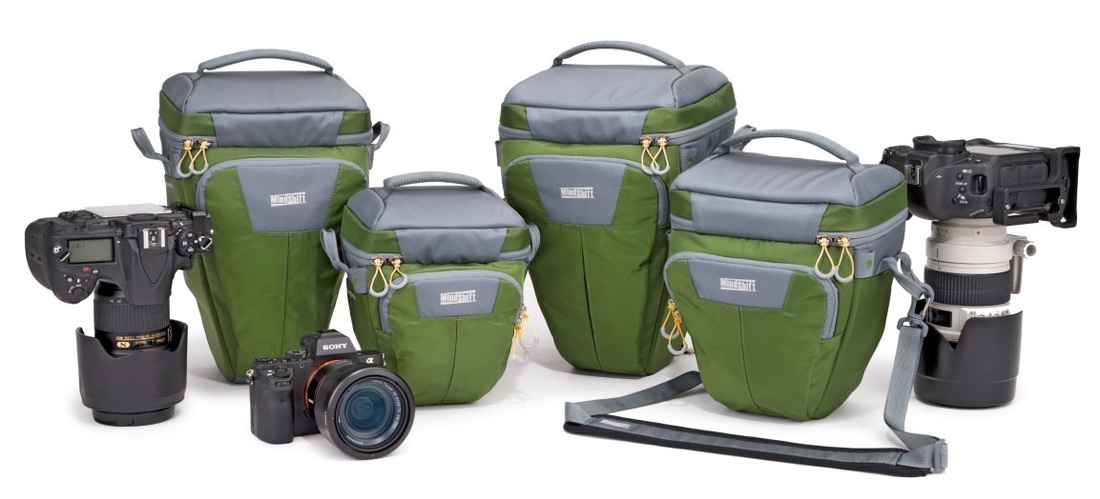 MindShift Gear's Multi-Mount Holster collection. Courtesy MindShift Gear. MindShift Gear's Multi-Mount Holster collection. Courtesy MindShift Gear. I can’t remember ever using a camera holster. Fact of the matter is, I find them too limiting. More to the point, I’m a photo backpack guy. Still, I was intrigued by the moniker Multi-Mount, so I opted to test out this new bag from MindShift Gear, one of my two favorite camera bag companies (along with Think Tank Photo). I chose to review the largest holster in this new lineup, the Multi-Mount Holster 50. And when the bag arrived and I initially holstered my Nikon D610, my first thought was: big mistake. What was I thinking? This bag is too roomy for a camera without a pro-grip. I should have ordered this bag one or two sizes smaller. So I let it sit around, and sit, and sit. Until one day, when I was retrofitting a backpack to give to a friend. Unlike some reviewers, I recycle my older camera bags. I even ask that the bag recipients make a small charitable contribution in place of paying me for the bag. Anyway, I came upon a padded divider that I’d stored. That’s another thing I do. Some packs—not any from MindShift or Think Tank, I might add—are just not worth giving to anyone, so I gut them and keep the dividers for later use, relegating these bags to other purposes, or just leaving them in the laundry room for any takers. Retrofitted to Suit My Needs So, here was this wedge-shaped divider that turned out to be a perfect fit for the Multi-Mount 50. Well, almost perfect. To make this an even better fit, I added a thick pad covered in Velcro-friendly material to the bottom of the holster. Which now meant I could secure the divider on three sides using its hook-and-loop tabs. (And, yes, that pad came from yet another old pack.) I wasn’t done. The holster included two narrow, thinly padded dividers. I don’t even recall where they were placed initially, but the first thing I did was to pull them out. It turned out that the wedge-shaped divider fell a bit short, leaving the top of the camera with the pentaprism housing exposed to bumps from anything sitting in the newly partitioned adjoining section. So I simply used these spare dividers to add to the height of the barrier. The arrangement was flexible enough to accommodate the top of the camera while isolating the two sections. Granted, I probably could have used the two spare dividers alone, without adding anything, but the divider that I did add was thicker and of a heavier density and I felt it would do a better job of separating one section from the other. Now I had room for my Nikon SB-700 flash in the ancillary section, with the D610 and attached Tamron 70-300mm zoom (or Tamron 24-70mm f/2.8 zoom) in the main, larger section. Could I do even better? (Note: the manufacturer recommends using the outside pocket for the flash, but I prefer keeping my flash where it would be better protected while on the move, then possibly sticking it in a photo vest pocket once I arrive at my destination.) 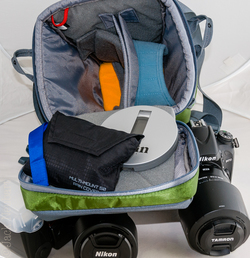 Multi-Mount Holster 50 customized to hold a DSLR with attached lens, a second lens, flash, rain cover, and filter, as well as additional items in the outside pocket. ©Jack Neubart. All rights reserved. Multi-Mount Holster 50 customized to hold a DSLR with attached lens, a second lens, flash, rain cover, and filter, as well as additional items in the outside pocket. ©Jack Neubart. All rights reserved. Room for More One day I’d decided to do some macro shooting, replacing the zoom with my Tamron 90mm f/2.8 macro. That meant I’d also need my Metz ring flash. Hmm, could I also make room for the SB-700 inside the bag? Why bother with the SB-700? I’ve often used a shoe-mount in place of the macro flash. The trick is to use the flash in bounce mode with the dome diffuser (diffusion dome) attached. That produces a soft, feathered light that doesn’t overwhelm the subject or create heavy, disturbing shadows behind it. Anyway, that step was simple enough. I added a layer of protection (another padded divider from the storage bin) over the ring flash and lay the shoe-mount on top. Next I wondered if I could make room for a second lens. Okay, something would have to give. I removed the ring flash. After all, the shoe-mount had greater utility. The Tamron macro was still on the camera, but I also wanted to take my Nikon 60mm macro, and as luck would have it, this lens was compact enough to fit in place of the ring flash, with the shoe-mount again riding on top. And There Was Room for Even More There is a zippered inside pocket—mesh so you can see what’s inside. I stuck the rain cover and a filter (inside its case) in there. I wasn’t done. I had an outside front pocket waiting to be filled. This space was relegated to anything that wasn’t easily damaged, which included batteries for the camera and flash, a white balance target, and Rocket blower. I was a happy camper. In Use First, you’re probably asking, how easy was it to get at the camera, now that I’d crowded it in with all the extras? Very easy indeed. I should point out that I’d attached a SpiderPro Hand Strap to the camera, with a BlackRapid Tripod Plate 70 at the bottom, which now lets me readily use a tripod when needed. While the bag would have accommodated a neck strap on the camera, a sling that attaches to the tripod socket would have been a bit much for this configuration. I would have had to make room, at the expense of the second section. The nice thing about this Spider wrist strap is that I’ve gotten so used to it that I no longer feel a need to hang the camera around my neck or deal with a long strap getting in my way. Wonder how I manage to hold onto the camera with that wrist strap for long periods without a neck strap or sling? Intermittently I rest the camera in my free hand, relax my grip for a moment or two, and flex my fingers. Simple, really. The holster comes with a waist belt. That made a big difference, securing the bag in place so it wouldn’t swing around as I bent over to shoot low when focusing on macro subjects. That meant that I wouldn’t constantly have to divert attention away from the subject and toward the bag in an effort to reposition the holster behind my back, where I generally like to keep it, rather than at my side. (Okay, it did slide around a little, since I don’t like to cinch the waist belt too tight, but it wasn’t enough to prove an annoyance as I was shooting.) The waist belt also takes some of the weight off your shoulder. However, it didn’t go far enough. Because I’d weighed the bag down by filling it to capacity, I found myself having to swap out the shoulder strap for one with a more substantial all-rubber shoulder pad, which also did a better job of gripping my shoulder. (Again, another remnant from a bag relegated to the throw-away pile.) That said, the shoulder pad on the shoulder strap that came with the bag is pliable enough so that it won’t dig into your neck when you wear it sling-style, if that’ how you prefer to wear a shoulder bag. The strap would also work well if you opted to wear the bag as a chest pack, with the strap draped around your neck. This holster bulked out too much for me to comfortably wear it in this fashion. That’s something I might have done with one of the smaller versions. I didn’t even try the other carrying modes. Again, if this were one of the smaller holsters, I would have entertained the notion of attaching it to my backpack. The bag also comes with a pair of tether straps that let you secure the holster to the back of the backpack; in front, as a chest pack but this time in tandem with the backpack; and as a waist pack, attached to the waist belt of the backpack, albeit at the front, lower down than you’d normally wear a chest pack. By letting the Multi-Mount ride tandem with a backpack, you can keep the camera in the holster, at your beck and call, while the rest of your gear rides comfortably on your back. What can I say? The Multi-Mount Holster gives you the best of all worlds, keeping gear safe and ready for use the moment inspiration strikes. I didn’t think I’d like it, but I do. I use it regularly. And now I’m glad I’ve got the Multi-Mount Holster 50, the biggest holster in the lineup, since it lets me carry enough gear to tackle whatever I expect to encounter during the day, or night.
A NEAT ACCESSORY Keep memory cards at the ready with MindShift Gear’s Card-Again memory card wallets. The CF version holds 4 cards; the SD version holds 6. If you get the CF version, as I did, you can store 2 SD cards in each slot. |
ReviewsTECHNICAL EDITOR
|

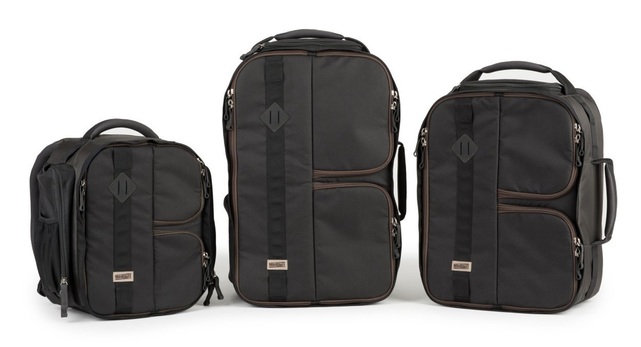
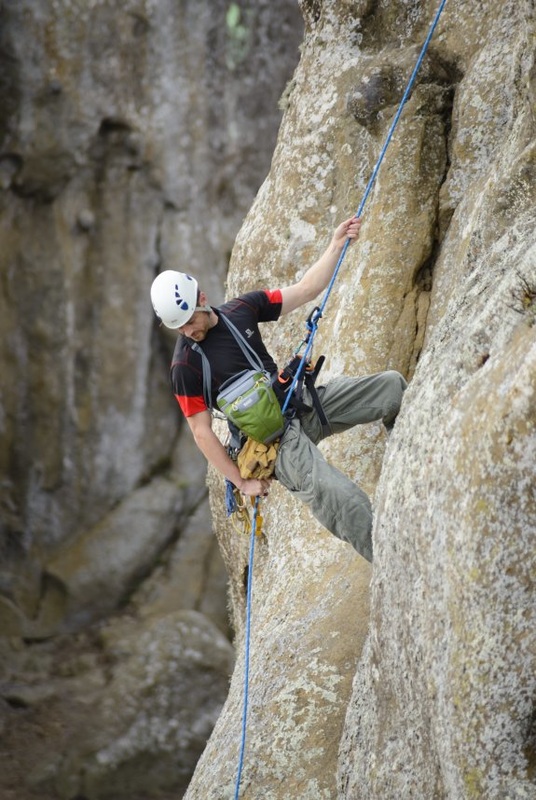
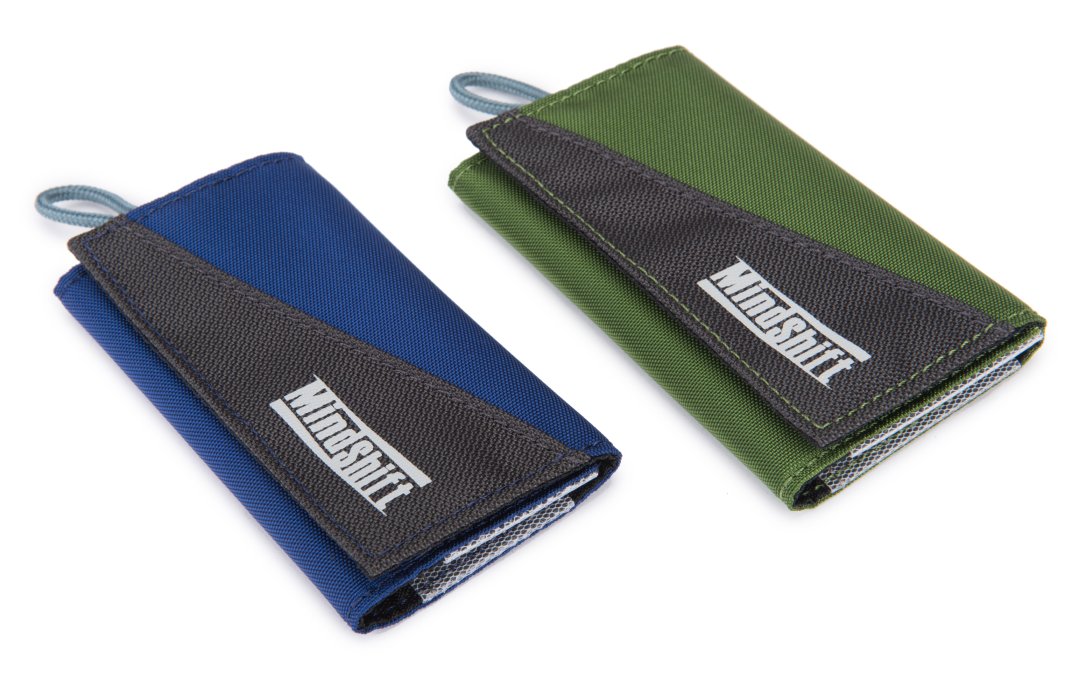
 RSS Feed
RSS Feed